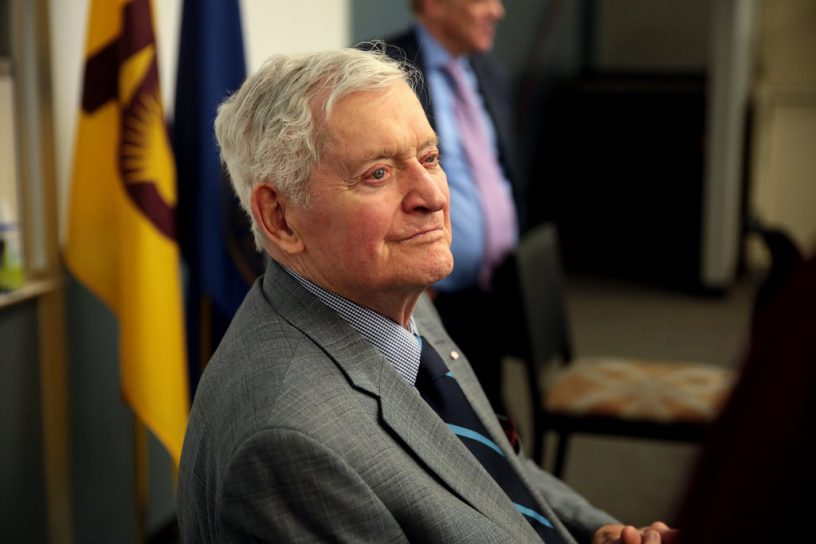John Turner is dead. The 17th Prime Minister of Canada died on Friday, September the 19th, 2020 at the prime age of 91, 36 years after his tenure in power. He was Canada’s second shortest serving Prime Minister, only lasting 79 days before losing an ill-called election to Mulroney’s Progressive Conservatives. Turner never returned to power.
It could be argued that John Turner’s tenure as prime minister was insignificant and inconsequential due to its considerable brevity. However, there’s more to a man than just a single title. Turner was the Leader of the Opposition, the Liberal Party Leader, the Minister of Justice, the Minister of Finance, a Member of Parliament and a Bay Street lawyer, among many other professional and personal roles.
In 1984, he won the leadership of the Liberal Party from Pierre Elliot Trudeau, whose titanic shadow on Canadian politics enshrouded him before and after his premiership. During the race to succeed Lester B. Pearson as Liberal leader in 1968, both were upstart ministers, recently appointed to cabinet, but P.E.T. leapfrogged over Turner to assume the leadership and the premiership. P.E.T. would hold both of these posts almost uninterrupted for the next 16 years.
Turner was then appointed to Justice Minister, the post P.E.T. held before he won, and presided over significant reforms. The Official Languages Act installed bilingualism as an official and legal framework, giving people the right to be served by the federal government in the language of choice. In one major revision of the criminal code, male homosexuality was decriminalized, abortions and contraception were legalized under specific circumstances, and drunk driving became a criminal offense. Turner’s deathday buddy, R.B.G., wishes she could.
In 1972, Turner moved into the most prestigious ministry in the Canadian government; Minister of Finance. Economic conditions were not ideal. “Les trentes glorieuses” of uninterrupted economic growth and Keynesian principles that succeeded World War 2 were coming to a close, and inflation had arrived on the scene in a big and bad way. Like most times, change was met with derision, and during the 1974 election, Opposition Leader Robert Stanfield’s calls for wage and price controls were mocked by P.E.T. However, the next year P.E.T. decided that that wasn’t such a bad idea. He ordered Turner to implement them. In response, Turner resigned from his position and seat, giving no explanation (at the time), and went to Bay Street to become a lawyer.
Long compared to J.F.K., Turner was perhaps the handsomest Prime Minister until Justin Trudeau. Princess Margaret, the late sister of Queen Elizabeth II, said she almost married him, but Buckingham Palace was hesitant about his Catholic faith. This was the type of person he was; in the big leagues, but just shy of glory. He had immigrated to Canada from England at a young age with his single mother, living in BC and Ottawa. By age 16 he was enrolled at the University of British Columbia where he won a Rhodes scholarship to Oxford – where he went on to earn three degrees – followed by doctoral studies at the University of Paris. His wife was an engineer at IBM in the 50’s, his children attended Upper Canada College and his step-father was the Lieutenant-Governor of British Columbia. Needless to say, he was the golden-haired boy. So when P.E.T. finally resigned in 1984, he was convinced to drop his Bay Street job, and sailed through P.E.T’s preferred candidate, Jean Chrétien, to become Leader of the Liberal Party and Prime Minister.
On condition that he leave office, P.E.T. appointed a raft of 200 patronage positions into the federal government – and when Turner arrived, he added 70 of his own. Based on rosy polling data several months out of date, Turner’s first move in office was to call an election. This action can be best described as rash. The Leader of the Opposition, Brian Mulroney, immediately hammered him for the appointments, painting him and the Grits as cronies who had become too comfortable in power. Turner, who seemed to have ignored the political jargon and tides of the past 9 years, fought back poorly.
He lost the election quite resoundingly, shedding 95 seats. The PCs won the majority of seats in every single province and became the last party to win a majority of the national vote. Turner stayed on as Leader of the Liberal Party, though with a much more tenuous hold on the leadership. This was aggravated when Mulroney pushed forward with NAFTA and the Meech Lake Accords (an attempt to provide a unique place for Quebec in the constitution), which each divided the Liberal caucus for or against. Turner decided to go pro-Meech Lake and anti-NAFTA.
During this time, there were rumours some Liberals wanted to replace Turner with P.E.T’s preferred successor Chrétien, though Turner vehemently denied this. The following election in 1988 was fought almost entirely on NAFTA, which Turner and the Liberals tried to equate to neo-colonialism. However, Mulroney won again, the only time a conservative Prime Minister won two majority governments from 1917 until today. NAFTA went ahead, which most agree was the right decision in hindsight. When the Meech Lake Accords wrapped up, P.E.T. loudly and publicly opposed them, undermining Turner’s stance, and resistance was mounted to block the implementation of the Accords. No substitute for the Accords ever passed, and the country is still united.
Turner resigned as Leader of the Opposition after losing his second election, and his preferred successor Paul Martin lost to P.E.T.’s Chrétien. He left the House of Commons and politics after the 1993 election and became an elder statesman, working with the U.N. and observing elections in emerging democracies. He will have a limited state funeral due to the COVID-19 Pandemic.





Leave a Reply